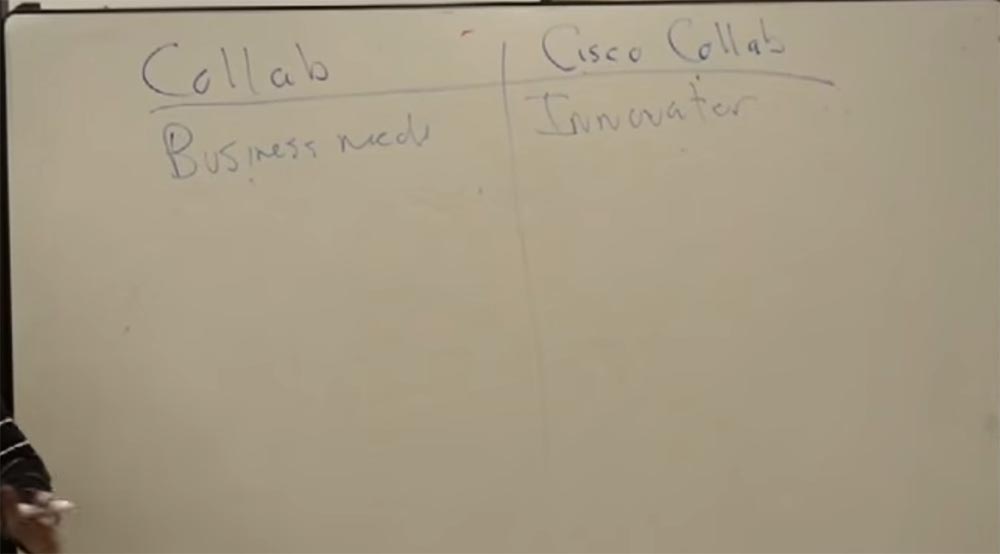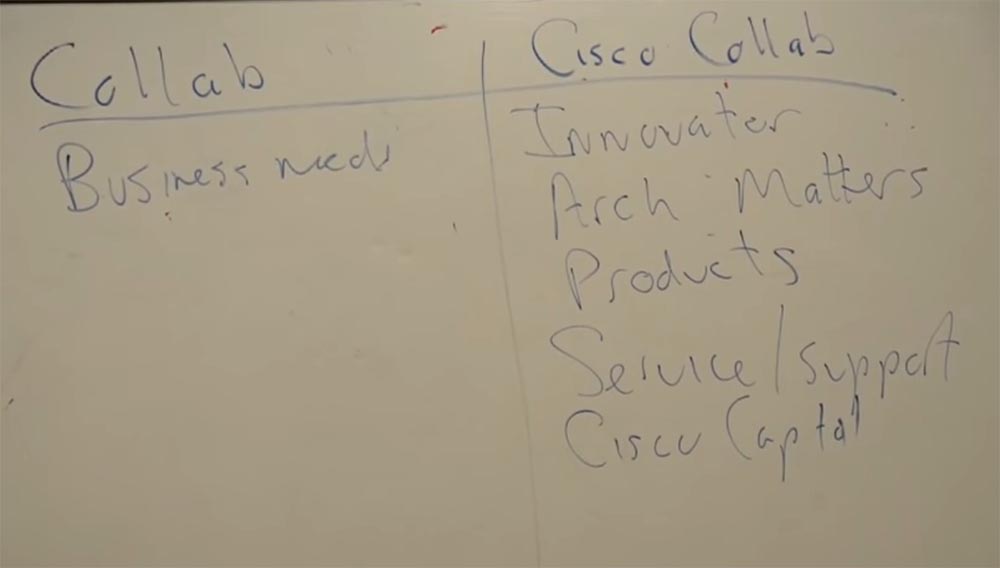FastTrack Training. "Network Basics". "Value of Collaboration Products from Cisco." Eddie Martin December 2012
About a year ago, I noticed an interesting and fascinating series of lectures by Eddie Martin, which, thanks to its history and real-life examples, as well as its tremendous learning experience, is amazingly comprehensible and allows you to gain an understanding of quite complex technologies.

We continue the cycle of 27 articles based on his lectures:
')
01/02: “Understanding the OSI Model” Part 1 / Part 2
03: "Understanding the Cisco Architecture"
04/05: “The Basics of Switching or Switches” Part 1 / Part 2
06: "Switches from Cisco"
07: "Area of use of network switches, the value of Cisco switches"
08/09: "Basics of a Wireless LAN" Part 1 / Part 2
10: "Products in the field of wireless LAN"
11: The Value of Cisco Wireless LANs
12: Routing Basics
13: "The structure of routers, routing platforms from Cisco"
14: The Value of Cisco Routers
15/16: “The Basics of Data Centers” Part 1 / Part 2
17: "Equipment for data centers"
18: "The Value of Cisco in Data Centers"
19/20/21: "The Basics of Telephony" Part 1 / Part 2 / Part 3
22: "Cisco Collaboration Software"
23: The Value of Collaboration Products from Cisco
24: "The Basics of Security"
25: "Cisco Security Software"
26: "The Value of Cisco Security Products"
27: "Understanding Cisco Architectural Games (Review)"
And here are the twenty third of them.
I use the technique you know and divide the board into 2 parts: just “Collaboration” on the left, and “Collaboration with Cisco products” on the right.
What do customers think about collaboration? Why is it an important aspect for customers? Because it is a business need. Well-established collaboration means a good connection between my team and a team of engineers, better knowledge between me and the development team. What product makes me noticeable in the market? Product to work together. The better I interact with clients, the higher my popularity. This makes me stand out from the mass of other participants in the process.
Remember, I gave an example when you come to the bank, and an employee tells you: “Good afternoon, Mr. Martin! How are you? What's up"? And all that, that is, you are a special client of the bank, and you are receiving increased attention. So, exactly the same happens in business.
Consider the company Procter & Gamble - 60% of research, development and innovation comes to them from external developers. If I can increase the level of collaboration between people within the enterprise and people outside it, I will raise my business to a new level. This is something that could not be done in the 70s, as it was not possible to accelerate the market.
The contact center is the main place in business, where ROI of ROI is tightly controlled. Transportation costs also play an important role. I hate trips, and it is difficult to persuade some of them to do this; they leave to monitor the field business no more than once a quarter and they don’t know what happens between their visits. They meet with partners at dinner, discuss problems, shake hands and all that. And when I come to these people, I don’t tell them that telepresentations will replace such trips for them, no, I’m saying that I want to help them work together between such trips, raise the level of cooperation in the business process. I tell clients that they can chat and video chat, send e-mail, call each other and exchange information with ease. And if you can say that you will not go anywhere this month, because you have the opportunity to conduct a television presentation - this is your choice.
We can open our customers' eyes to such processes in business that they did not even suspect, find out how they themselves evaluate their effectiveness. This means that we must actively participate in their activities and see how these processes work today, understand whether they do not coincide with the technologies that we can provide to customers to improve these processes. And if we provide them with such technologies, customers will even be able to tell us how they are going to measure their effectiveness and how they can be made much easier for more users.
For example, I ask how many phones you want to transfer and they answer me: “I have 2000 phones this year, at $ 100 per phone,” I will help you save this money! This is the same ROI that must be respected.
Each client must be approached individually, because clients differ from each other. Many of our customers are under IT that control their mind and imagination. Customers hope someone from IT will come and say, “Hey, how are you doing your business? Maybe I can make the network suitable for video and help you with it ”? Nothing like this will happen! The IT department wakes up in the morning and does not want it! It is our responsibility to give businesses such opportunities, and not the occupation of "IT people."
Collaboration products help to say who needs to be with whom, they connect those who sell and those who buy to people who know how aggressively or kindly they need to deal with a participant in the process. How can I get knowledge from such people? Only if I give the opportunity to communicate with them on social networks.
Now let's move on to the second half - "Collaboration with Cisco products." Cisco is an innovator in this area. She was engaged in innovation from the very beginning, then it was also called IP-telephony.

Our collaborative architecture originated in 1997, when John Chambers talked about combining voice and data. At that time we did not call it collaboration, we called it IP telephony, but we developed it for collaboration.
Innovations are followed by architectural issues.
Clients called me and said they wanted IP telephony. Is it not good when customers call you and say they want our products? They said they contacted other companies about telephony, switches, PoE and Avaya told them that Cisco is the best company in this area. How can you not love such calls?
Our architecture meets the most diverse needs of customers, it works perfectly and is embedded in any business structure. This proves that the issues of our architecture relate not only to collaboration, but also are the engine of an independent architecture for business.

Suppose that in one place we have contractor A, in another supplier B, supplier C is located here, manufacturer G is there, and our architecture can connect them all together. If we add a new supplier unknown to us every time, our risks increase exponentially. Here you have the opportunity to work with trusted people.
The third item is collaboration products, and the fourth is services and support. Most collaboration products need this. Once again I will say that Cisco has a long history of customer support, and you just have to keep services for this, because customers are not able to do everything themselves. Consulting assistance to clients is also our service.
Finally, the last item is Cisco investment.
As for services, I will say that they are prepaid or paid upon completion. The latter are more common first.
Continued:
FastTrack Training. "Network Basics". "Security basics". Eddie Martin December 2012
Thank you for staying with us. Do you like our articles? Want to see more interesting materials? Support us by placing an order or recommending to friends, 30% discount for Habr users on a unique analogue of the entry-level servers that we invented for you: The Truth About VPS (KVM) E5-2650 v4 (6 Cores) 10GB DDR4 240GB SSD 1Gbps $ 20 or how to share the server? (Options are available with RAID1 and RAID10, up to 24 cores and up to 40GB DDR4).
Dell R730xd 2 times cheaper? Only we have 2 x Intel Dodeca-Core Xeon E5-2650v4 128GB DDR4 6x480GB SSD 1Gbps 100 TV from $ 249 in the Netherlands and the USA! Read about How to build an infrastructure building. class c using servers Dell R730xd E5-2650 v4 worth 9000 euros for a penny?

We continue the cycle of 27 articles based on his lectures:
')
01/02: “Understanding the OSI Model” Part 1 / Part 2
03: "Understanding the Cisco Architecture"
04/05: “The Basics of Switching or Switches” Part 1 / Part 2
06: "Switches from Cisco"
07: "Area of use of network switches, the value of Cisco switches"
08/09: "Basics of a Wireless LAN" Part 1 / Part 2
10: "Products in the field of wireless LAN"
11: The Value of Cisco Wireless LANs
12: Routing Basics
13: "The structure of routers, routing platforms from Cisco"
14: The Value of Cisco Routers
15/16: “The Basics of Data Centers” Part 1 / Part 2
17: "Equipment for data centers"
18: "The Value of Cisco in Data Centers"
19/20/21: "The Basics of Telephony" Part 1 / Part 2 / Part 3
22: "Cisco Collaboration Software"
23: The Value of Collaboration Products from Cisco
24: "The Basics of Security"
25: "Cisco Security Software"
26: "The Value of Cisco Security Products"
27: "Understanding Cisco Architectural Games (Review)"
And here are the twenty third of them.
FastTrack Training. "Network Basics". "Value of Collaboration Products from Cisco." Eddie Martin December 2012
I use the technique you know and divide the board into 2 parts: just “Collaboration” on the left, and “Collaboration with Cisco products” on the right.
What do customers think about collaboration? Why is it an important aspect for customers? Because it is a business need. Well-established collaboration means a good connection between my team and a team of engineers, better knowledge between me and the development team. What product makes me noticeable in the market? Product to work together. The better I interact with clients, the higher my popularity. This makes me stand out from the mass of other participants in the process.
Remember, I gave an example when you come to the bank, and an employee tells you: “Good afternoon, Mr. Martin! How are you? What's up"? And all that, that is, you are a special client of the bank, and you are receiving increased attention. So, exactly the same happens in business.
Consider the company Procter & Gamble - 60% of research, development and innovation comes to them from external developers. If I can increase the level of collaboration between people within the enterprise and people outside it, I will raise my business to a new level. This is something that could not be done in the 70s, as it was not possible to accelerate the market.
The contact center is the main place in business, where ROI of ROI is tightly controlled. Transportation costs also play an important role. I hate trips, and it is difficult to persuade some of them to do this; they leave to monitor the field business no more than once a quarter and they don’t know what happens between their visits. They meet with partners at dinner, discuss problems, shake hands and all that. And when I come to these people, I don’t tell them that telepresentations will replace such trips for them, no, I’m saying that I want to help them work together between such trips, raise the level of cooperation in the business process. I tell clients that they can chat and video chat, send e-mail, call each other and exchange information with ease. And if you can say that you will not go anywhere this month, because you have the opportunity to conduct a television presentation - this is your choice.
We can open our customers' eyes to such processes in business that they did not even suspect, find out how they themselves evaluate their effectiveness. This means that we must actively participate in their activities and see how these processes work today, understand whether they do not coincide with the technologies that we can provide to customers to improve these processes. And if we provide them with such technologies, customers will even be able to tell us how they are going to measure their effectiveness and how they can be made much easier for more users.
For example, I ask how many phones you want to transfer and they answer me: “I have 2000 phones this year, at $ 100 per phone,” I will help you save this money! This is the same ROI that must be respected.
Each client must be approached individually, because clients differ from each other. Many of our customers are under IT that control their mind and imagination. Customers hope someone from IT will come and say, “Hey, how are you doing your business? Maybe I can make the network suitable for video and help you with it ”? Nothing like this will happen! The IT department wakes up in the morning and does not want it! It is our responsibility to give businesses such opportunities, and not the occupation of "IT people."
Collaboration products help to say who needs to be with whom, they connect those who sell and those who buy to people who know how aggressively or kindly they need to deal with a participant in the process. How can I get knowledge from such people? Only if I give the opportunity to communicate with them on social networks.
Now let's move on to the second half - "Collaboration with Cisco products." Cisco is an innovator in this area. She was engaged in innovation from the very beginning, then it was also called IP-telephony.

Our collaborative architecture originated in 1997, when John Chambers talked about combining voice and data. At that time we did not call it collaboration, we called it IP telephony, but we developed it for collaboration.
Innovations are followed by architectural issues.
Clients called me and said they wanted IP telephony. Is it not good when customers call you and say they want our products? They said they contacted other companies about telephony, switches, PoE and Avaya told them that Cisco is the best company in this area. How can you not love such calls?
Our architecture meets the most diverse needs of customers, it works perfectly and is embedded in any business structure. This proves that the issues of our architecture relate not only to collaboration, but also are the engine of an independent architecture for business.

Suppose that in one place we have contractor A, in another supplier B, supplier C is located here, manufacturer G is there, and our architecture can connect them all together. If we add a new supplier unknown to us every time, our risks increase exponentially. Here you have the opportunity to work with trusted people.
The third item is collaboration products, and the fourth is services and support. Most collaboration products need this. Once again I will say that Cisco has a long history of customer support, and you just have to keep services for this, because customers are not able to do everything themselves. Consulting assistance to clients is also our service.
Finally, the last item is Cisco investment.
As for services, I will say that they are prepaid or paid upon completion. The latter are more common first.
Continued:
FastTrack Training. "Network Basics". "Security basics". Eddie Martin December 2012
Thank you for staying with us. Do you like our articles? Want to see more interesting materials? Support us by placing an order or recommending to friends, 30% discount for Habr users on a unique analogue of the entry-level servers that we invented for you: The Truth About VPS (KVM) E5-2650 v4 (6 Cores) 10GB DDR4 240GB SSD 1Gbps $ 20 or how to share the server? (Options are available with RAID1 and RAID10, up to 24 cores and up to 40GB DDR4).
Dell R730xd 2 times cheaper? Only we have 2 x Intel Dodeca-Core Xeon E5-2650v4 128GB DDR4 6x480GB SSD 1Gbps 100 TV from $ 249 in the Netherlands and the USA! Read about How to build an infrastructure building. class c using servers Dell R730xd E5-2650 v4 worth 9000 euros for a penny?
Source: https://habr.com/ru/post/351418/
All Articles